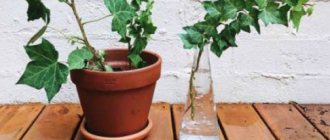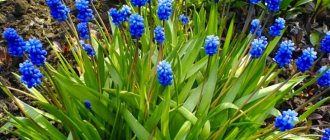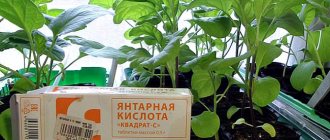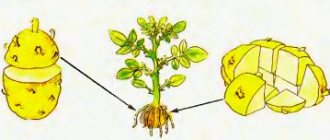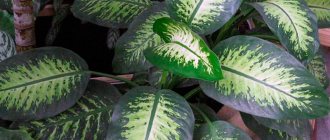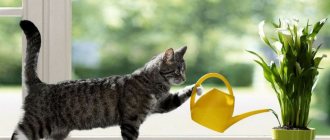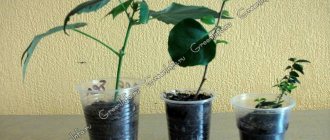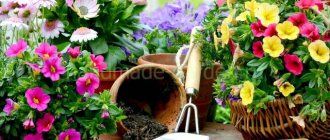Every apartment or house will look empty and uncomfortable if there are no indoor plants. Indoor plants enliven any room and create a unique microclimate.
You can add an elegant touch to the interior design of an apartment or house by using not only individual plants, but also compositions of indoor flowers. Designers and florists can combine small and large plants, smooth and prickly, flowering and non-blooming, bright and muted in shades.
The most important rule in this case will be that the plants can grow next to each other, and they will not have to be transplanted to other places.
Obviously, the rules for caring for plants in a composition with common soil should be the same. In the case of a combination of plants in their own pots, the space between them is filled with decorative material (sisal, colored pebbles, pebbles). Florists often use the latter option as a gift, combining potted plants in a large wicker basket.
Indoor plants in the interior of an apartment, correctly assembled into a single composition, represent a living decor that looks harmonious against the background of other things.
In order to create compositions from indoor plants, you need to understand what types of compositions there are and know the rules for their composition. Having learned this information, not only a florist, but also any gardener will be able to create beautiful mini-gardens from indoor flowers.
Solitaire composition
A tapeworm is a garden decoration using a separately growing tree, bush or grass with a tall stem. Therefore, a home solitaire composition consists of several large and compatible plants that have an unusual shape, color of leaves or flowers.
The best species for this are palms, monsteras, ficuses and codiaums. Tall flowers should be planted in bright, non-standard shaped pots with an unusual texture or pattern. By the way, tapeworms are suitable not only for decoration, but also for zoning rooms. Tall colors make it easy to separate areas of the room that have different purposes. Solitaires can also fill an empty niche or corner.
A selection of tall flowers for the home
The dimensions of a large room will emphasize large crops. A luxurious plant in a voluminous planter will become a noticeable spot in the interior. With the help of living decor, designers pay attention to the beauty of the design, making the space harmonious and close to nature.
Philodendron
An evergreen perennial with huge curly leaves looks gorgeous in the interior of a living room or office. A tropical flower with fleshy stems up to 2 m in length is supported on a support. The price for a young specimen (up to 40 cm) is from 1000 rubles, the cost of adult species reaches 25-30 thousand. The following varieties are grown in the apartment:
- warty;
- Sello;
- guitar-shaped;
- climbing
Philodendron prefers to grow in diffuse sun conditions. The culture grows at temperatures within 20-25 C; when it is hot, you will have to increase the humidity or turn on the air conditioning. The plant does not like drafts and will die at 15 C. Water the flower abundantly in spring and summer, drain the remaining liquid from the pan, in autumn and winter - as the soil dries out.
Large plant for the interior Source journal.homemania.ru
Hibiscus
Chinese rose is a beautiful plant that pleases with huge bright buds. The price of rooted cuttings is from 70 rubles, large specimens from 1.5 meters cost 500 rubles. The crop is grown in a shaded place or in diffused light. Flowering lasts from spring to early autumn. The decorative species prefers to develop in a temperature range of 18-20 C, and falls asleep at 15 C.
To stimulate the appearance of buds, old branches are pruned at the beginning of the growing season. From April to September, fertilizing for flowering species is applied every 2 weeks. The culture loves high humidity, so in hot weather it is sprayed with water from a spray bottle. Water the Chinese rose after the soil has dried to a depth of 2 cm.
Blooming look for the interior Source yapokupayu.ru
The price of a luxury palm with fan-shaped leaves depends on the size. Young flowers up to 40 cm in height cost from 1.9 thousand rubles, teenagers up to 1 m - from 9 thousand. For healthy development, bright but diffused light is needed. In spring and summer, the crop grows at temperatures from 20 to 28 C, in winter – within 14-18 C.
Liviston in room design Source roomble.com
From April to September, abundant watering and regular application of fertilizers for palm trees. In hot weather, increase humidity by spraying and wiping the foliage. From October, the flower stops its growing process and irrigation is reduced to a minimum.
Compositions from potted plants
In order to create such a composition, select several types of plants that are united by a common color or leaf shape, as well as similar shades of flowers. Don’t forget to choose several beautifully flowering or decorative foliage species, as they will become the main accent of the composition.
To make your creation look even more harmonious, plant all the flowers in the same or similar pots in concept. You can decorate a window sill, shelves or a small area on the floor with a potted arrangement.
Features of keeping green plants in a warm, dry room
Compositions of potted plants kept in rooms with central heating that require humidified air are usually placed on special trays covered with a layer of pebbles. The main thing is to take a waterproof stand with a depth of 4-5 cm. The length and width are selected based on personal considerations or the volume of the indoor garden.
Having prepared everything you need, pour pebbles onto the bottom of the tray and spread them in a thin layer (2-2.5 cm). Then pour water so that the lower pebbles are in the water. Flowerpots are placed on pebbles, and the structure can even be placed on a shelf near the radiator. With this placement, the air humidity around the plants increases 3-5 times.
During watering, excess water drips into the tray. When evaporated, it promotes a favorable environment for the development of green plants as part of a composition of potted plants.
Vertical compositions
If you don’t want to clutter your window sills, floors and other horizontal surfaces in the house with flower pots, but you’re also not ready to give up greenery, try making a neat vertical composition.
Compact plants such as violets, ferns, gloxinias and succulents are suitable for this. Place the selected flowers on tall and narrow floor stands. If you decide to use hanging species, such as fuchsias, begonias or ivies, the plants can be placed in hanging pots.
Landing technology
How to make a composition from succulents with your own hands
First of all, you need to put good drainage in the pot so that moisture does not stagnate near the roots. Can be used:
- a mixture of perlite and vermiculite in a 1:1 ratio;
- expanded clay;
- clay shards;
- Styrofoam;
- small pebbles.
The substrate must be suitable for this type of plant. Some gardeners recommend adding hydrogel to the soil or drainage - it absorbs moisture when it is in excess and releases it if the soil dries out. This helps regulate soil moisture, preventing both rotting and drying out of the roots.
After planting, it is recommended to cover the soil with mulch, for example, sphagnum moss. It protects the soil from drying out, prevents root rot, and has bactericidal properties.
Some people use pebbles for covering.
Indoor kindergarten
Fill a large container with a few small plants and you have a miniature home garden. There is no need to worry that the edges of the pots will “peek out” from the container, as they will be hidden behind the foliage or the walls of the container itself.
Also try planting plants directly into containers, avoiding individual pots entirely. Succulents, violets, indoor roses and other miniature flowers look most harmonious in a home garden.
How to make a mini garden in a pot with your own hands
This work is created mainly using improvised means, and making it is not as difficult as it seems. It is important to have a good mood, thanks to which your imagination will quickly tell you how to turn seemingly unnecessary things into a real home masterpiece.
Deciding on the general idea and style of the composition
As already mentioned, before creating a garden you need to decide what concept the future composition will have. You need to proceed from the available means and characteristics of the plants. It is better to decide in advance where exactly the miniature garden will be located. Then it is easier to choose which flowers will be included in the composition - shade-loving or vice versa, needing light, tall or short, etc. When it comes to home use of a future work, you need to take into account the interior of the room - what tones predominate, what kind of lighting, features of the room’s space, furniture, etc.
DIY mini-garden in a pot (video)
In order for the garden to fit organically into the interior, you need to think carefully about its plot. The number of ideas is endless, and here are just a few of them:
- island in the tropics;
- mini-zoo (if there are animal figures);
- a themed kindergarten dedicated to some celebration (birthday, wedding anniversary, etc.);
- alpine slides;
- Japanese kindergarten;
- Amazonian jungle;
- a skit based on a famous story, song, fairy tale (it will be especially interesting for children);
- miniature of your own country garden;
- Chinese kindergarten;
- medieval castle with fields around;
- a garden with tiers (like the Hanging Gardens of Babylon);
- seasonal theme (spring, summer garden);
- country style garden and many others.
The easiest way to get inspired is to see the garden in real life at an exhibition, in a store or at a visit. Photographs of finished compositions are no less effective. You can take all the best examples as a basis and create your own masterpiece. Also a good source of inspiration and ideas is a master class by professional florists. Of course, you can come up with your own unique version - it will be even more interesting to work with.
Choosing a planting container for a mini-garden
To get started, it is important to choose the basis of the garden - the container in which it will be placed. Almost any pot, bathtub, old sink and many other available tools are suitable for these purposes. It is important that the vessel is high enough - preferably 20-30 cm and as wide as required. Usually gardens are made on a wide horizontal surface, so the width of the container is of great importance.
The shape of the container can be any - round, oval, square, curved, etc. Warm-colored ceramic products will look organically fit into the design (just like the usual flower pots). However, the choice of color and material is more a matter of taste. The only main requirement is the presence of holes to drain excess water.
It is better to decorate the bottom of the container with pebbles and small crushed stones or other stones to ensure drainage. The outside of the container can be beautifully decorated with colored stones and shells - this is where imagination comes into play again. First, a solution is made from equal proportions of sand and cement, to which water is added until a dough-like mass is obtained. The freshly prepared mixture is carefully spread on the edges of the container, then the decoration elements are stuck on and left to dry.
An interesting option is when a porous stone that can allow moisture to pass through is used as a container , for example, limestone, tuff, shell rock. They are usually used in summer cottages. Flower arrangements in stones look more natural and interesting.
And perhaps the most original option is a garden in a bowl (small container). This variety will appeal to lovers of minimalism. You can plant the smallest plants, and decorative elements can be made up of small details (for example, a small house with a birdhouse).
Plants and mini-flowers for a miniature garden
Perhaps the main criterion in selecting plants for a future composition is not too vigorous growth of flowers. The fact is that it is better not to replant plants or cut off excess greenery too often, otherwise it will harm both the appearance of the garden and its inhabitants. It is also worth considering that if you decorate the composition with stones, the roots of the plants should be unpretentious and strong enough to break through them.
Of course, an important factor is the decorative value of the plant, that is, how beautiful it will look in a pot. Here are some good tricks to know:
- Helxina grows very well and produces a lot of greenery that will decorate the garden;
- miniature roses, Saintpaulias, streptocarpus will help make the garden bright and original - as if we have a miniature flowerbed in front of us;
- fittonia has small flowers of different shades - white, red, pink, green: this will give a beautiful color scheme in the garden;
- dwarf spruce serves as an excellent prototype of a tree - it is better to plant it in a central place;
- thick leaves of pachyphytum will emphasize the exotic theme;
- ivy will give the composition an original cover and graceful forms;
- different types of cacti, due to their diversity, will fit perfectly into almost any flower arrangement - in the form of a mini-palm tree, tree or cactus itself, if the garden, for example, has Mexican motifs.
Rules for composition, placement and planting of plants
The rules for composing a flower arrangement are related to the design features of the garden. The main goal is to combine flowers favorably and highlight the advantages of each of them. Florists recommend proceeding from the following general principles:
- if the main view of the garden is on one side, then it is better to plant large plants in the background, and smaller ones in the front;
- if it is assumed that access to the container will be from all sides. then the bush trees should be placed in the center, and small flowers - along the edges;
- to create dynamics, it is better to plant plants not one after another, but in cascades and not in a straight line, but in zigzags; perhaps you should come up with your own patterns;
- A very correct decision would be to arrange a beautiful background and lighting for the garden so that it looks as attractive as possible.
Decorating a mini-garden with decorative elements
Decorative elements of the garden can be very diverse. They should not only fit harmoniously into the composition, but also favorably emphasize the advantages of the plants, as well as create a pleasant mood for contemplators. A variety of means can be used:
- materials for decoration (sand, colored stones, shells, pebbles);
- figurines of animals and people;
- models of houses, castles, fences, arches;
- details for creating natural landscapes (such as rocky terrain, prairie, waterfall and more);
- home comfort items (benches, chairs);
- themed figures (heroes of fairy tales, cartoons).
There can be a lot of ideas. When you have chosen the necessary decorations, it is important to fit them correctly into the design, and in the case of figurines, to fix them in the ground. You can simply dig them in, or you can pre-attach them to a platform (for example, a house), which is fixed in the ground.
Florarium
A florarium or, as it is also called, a plant terrarium is a transparent container made of glass or other suitable material in which homemade flowers grow. Typically, slow-growing and moisture-loving tropical species are bred in florariums, since high humidity and temperature are maintained in the container.
Often glass containers have unusual shapes, so the florarium can easily be confused with an exotic element of the interior. To make a transparent pot look even more impressive, add moss, beautiful stones, shells, figurines and decorative soil.
Shrubs on the site: principles for choosing a planting site
There are three important things to keep in mind when choosing a location:
firstly, the shrubs are perennial and they will live in the allotted space for more than ten years, so it is necessary to immediately assess how much the area occupied by plantings may be affected by further redevelopment; secondly, many “greens” present their demands on natural conditions in the form of an ultimatum. They should be taken into account so that the heart does not bleed at the sight of a juniper burning in the sun or a forsythia dying in the deep shadow
In addition, many varieties of ornamental shrubs cannot tolerate dry and cold winds; thirdly, a small bush planted next to a path can, in a few years, become a serious obstacle to movement around the site, that is, the dimensions of an already mature plant must be taken into account.
Rutary
Rutaria is the name given to decorating a garden with roots, stumps and branches of various bizarre shapes. Homemade rutarium is a combination of potted plants and wood. As a base, use one or more roots and stumps of unusual shape, having prepared small depressions in them in advance.
The shape and size of these recesses should match the flower pots. To make the rutarium fit well into the interior style, you can repaint the wood in a more suitable color.
The ideas described above can be used to decorate any interior. Plants will equally well enliven the appearance of both large and small apartments. The main thing is to choose flowers that will be easy for you to care for.
Aloe and cactus
Aloe is a popular herbaceous perennial. It belongs to succulents, which means you can water it once a month. Aloe leaves are dense and fleshy, this is due to the plant’s homeland. In hot countries it rarely rains; plants accumulate moisture in advance. Flower growers love aloe for its unpretentiousness and beneficial properties.
Cactus is an evergreen succulent familiar to everyone. It is believed that cacti have not changed in appearance since ancient times. The cactus has no leaves; they are replaced by needles, bristles or hairs.
Aloe and cactus will get along in the same pot because they are succulents and accumulate moisture in their stems and roots. A loose, airy substrate is suitable for these flowers. They are unpretentious, no floriculture skills are required.
Stages of creation
Having decided on the container and decorated it, pour expanded clay drainage onto the bottom or use pebbles for this. The soil mixture is prepared from 2 parts coarse sand, 1 part turf soil and 1 part peat. To give it looseness, add a small amount of vermiculite.
Plants are planted directly into the ground or dug into pots to prevent the roots from intertwining. Then at any time an individual plant can be replaced or simply removed. This method also solves the problem of compatibility of different types. It is better to bury the pots so that they are not visible. Do not add 2 cm of soil to the edge of the container. To make the neighborhood successful, you should consider whether the plants like sun or shade, plenty of moisture or dry soil.
After planting the plants, the fun part begins – decorating. Empty areas are covered with small crushed stone, decorative stones, and garden paths are laid out. These measures also help retain moisture and prevent weeds.
To create a “reservoir”, a small low vessel is suitable, which is dug into the ground, and the bottom is covered with small pebbles. The illusion of water in a stream or river or the surface of the sea can be created using transparent blue glass balls.
There are three ways to organize a mini-garden:
- In a flowerpot: where all the elements are located on the surface of the earth in the same plane.
- In a broken pot: carefully beat off part of the pot on the side with a hammer and separate several small fragments from it. The broken wall is dug into the ground, and steps from the base to the top are laid out from small parts - an interesting two-level garden is obtained.
- A multi-tiered composition of 4 pots of different sizes. The large pot is left intact and filled with drainage and soil. In the next largest pot, they beat off a part and dig it into the ground, do the same with the next one, but dig it into the previous pot. One broken piece is placed on top and the smallest pot is placed in it, and small tiles for steps are broken off from the remaining piece. Thus, the area for planting and decoration is significantly increased.
Children's toys and doll furniture can be used as decoration. Houses and small elements are beautifully molded from salt dough and polymer clay. You can put an LED candle inside or use glowing paints.
Wood or wire can be used to make original fences, benches; decor can also be easily created from matches, plasticine, skewers, twigs, bottle caps and other available materials. There is also room for a fire with a cauldron, swings and stairs. A nice addition to the overall picture will be wheelbarrows and carts, garden arches, bridges, straw baskets and hats, bird nests, “forgotten” watering cans and shovels. Just don’t get too carried away with the decor and overload your corner of nature with them, because, first of all, this is a garden with living plants, albeit in miniature form.


